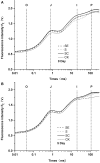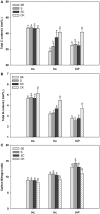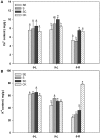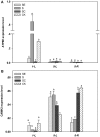Exogenous Calcium Enhances the Photosystem II Photochemistry Response in Salt Stressed Tall Fescue
- PMID: 29250091
- PMCID: PMC5715236
- DOI: 10.3389/fpls.2017.02032
Exogenous Calcium Enhances the Photosystem II Photochemistry Response in Salt Stressed Tall Fescue
Abstract
Calcium enhances turfgrass response to salt stress. However, little is known about PSII photochemical changes when exogenous calcium was applied in salinity-stressed turfgrass. Here, we probe into the rearrangements of PSII electron transport and endogenous ion accumulation in tall fescue (Festuca arundinacea Schreber) treated with exogenous calcium under salt stress. Three-month-old seedlings of genotype "TF133" were subjected to the control (CK), salinity (S), salinity + calcium nitrate (SC), and salinity + ethylene glycol tetraacetic acid (SE). Calcium nitrate and ethylene glycol tetraacetic acid was used as exogenous calcium donor and calcium chelating agent respectively. At the end of a 5-day duration treatment, samples in SC regime had better photochemistry performance on several parameters than salinity only. Such as the Area (equal to the plastoquinone pool size), N (number of [Formula: see text] redox turnovers until Fm is reached), ψE0, or δRo (Efficiencdy/probability with which a PSII trapped electron is transferred from QA to QB or PSI acceptors), ABS/RC (Absorbed photon flux per RC). All the above suggested that calcium enhanced the electron transfer of PSII (especially beyond [Formula: see text]) and prevented reaction centers from inactivation in salt-stressed tall fescue. Furthermore, both grass shoot and root tissues generally accumulated more C, N, Ca2+, and K+ in the SC regime than S regime. Interrelated analysis indicated that ψE0, δRo, ABS/RC, C, and N content in shoots was highly correlated to each other and significantly positively related to Ca2+ and K+ content in roots. Besides, high salt increased ATP6E and CAMK2 transcription level in shoot at 1 and 5 day, respectively while exogenous calcium relieved it. In root, CAMK2 level was reduced by Salinity at 5 day and exogenous calcium recovered it. These observations involved in electron transport capacity and ion accumulation assist in understanding better the protective role of exogenous calcium in tall fescue under salt stress.
Keywords: PSII photochemistry; carbon and nitrogen assimilation; exogenous calcium; salt stress; tall fescue.
Figures






Similar articles
-
Alleviation of heat damage to photosystem II by nitric oxide in tall fescue.Photosynth Res. 2013 Sep;116(1):21-31. doi: 10.1007/s11120-013-9883-5. Epub 2013 Jul 6. Photosynth Res. 2013. PMID: 23832593
-
The Alleviation of Heat Damage to Photosystem II and Enzymatic Antioxidants by Exogenous Spermidine in Tall Fescue.Front Plant Sci. 2017 Oct 12;8:1747. doi: 10.3389/fpls.2017.01747. eCollection 2017. Front Plant Sci. 2017. PMID: 29075277 Free PMC article.
-
Ascorbic Acid Alleviates Damage from Heat Stress in the Photosystem II of Tall Fescue in Both the Photochemical and Thermal Phases.Front Plant Sci. 2017 Aug 8;8:1373. doi: 10.3389/fpls.2017.01373. eCollection 2017. Front Plant Sci. 2017. PMID: 28848577 Free PMC article.
-
Transcriptomic profiling revealed the role of 24-epibrassinolide in alleviating salt stress damage in tall fescue (Festuca arundinacea).Front Plant Sci. 2022 Sep 22;13:976341. doi: 10.3389/fpls.2022.976341. eCollection 2022. Front Plant Sci. 2022. PMID: 36212305 Free PMC article.
-
Stress memory gene FaHSP17.8-CII controls thermotolerance via remodeling PSII and ROS signaling in tall fescue.Plant Physiol. 2021 Nov 3;187(3):1163-1176. doi: 10.1093/plphys/kiab205. Plant Physiol. 2021. PMID: 34009359 Free PMC article.
Cited by
-
How salt stress-responsive proteins regulate plant adaptation to saline conditions.Plant Mol Biol. 2022 Feb;108(3):175-224. doi: 10.1007/s11103-021-01232-x. Epub 2021 Dec 29. Plant Mol Biol. 2022. PMID: 34964081 Review.
-
Turfgrass Salinity Stress and Tolerance-A Review.Plants (Basel). 2023 Feb 17;12(4):925. doi: 10.3390/plants12040925. Plants (Basel). 2023. PMID: 36840273 Free PMC article. Review.
-
Potential of Ca-Complexed in Amino Acid in Attenuating Salt Stress in Sour Passion Fruit Seedlings.Plants (Basel). 2024 Oct 17;13(20):2912. doi: 10.3390/plants13202912. Plants (Basel). 2024. PMID: 39458859 Free PMC article.
-
Physiological mechanisms of exogenous calcium on alleviating salinity-induced stress in rice (Oryza sativa L.).Physiol Mol Biol Plants. 2019 May;25(3):611-624. doi: 10.1007/s12298-019-00654-8. Epub 2019 Apr 13. Physiol Mol Biol Plants. 2019. PMID: 31168227 Free PMC article.
-
Effects of exogenous calcium additions on the ecological stoichiometric characteristics of various organs and soil nutrients and their internal stability in Pinus tabuliformis.Front Plant Sci. 2024 Sep 5;15:1428011. doi: 10.3389/fpls.2024.1428011. eCollection 2024. Front Plant Sci. 2024. PMID: 39301157 Free PMC article.
References
LinkOut - more resources
Full Text Sources
Other Literature Sources
Research Materials
Miscellaneous

